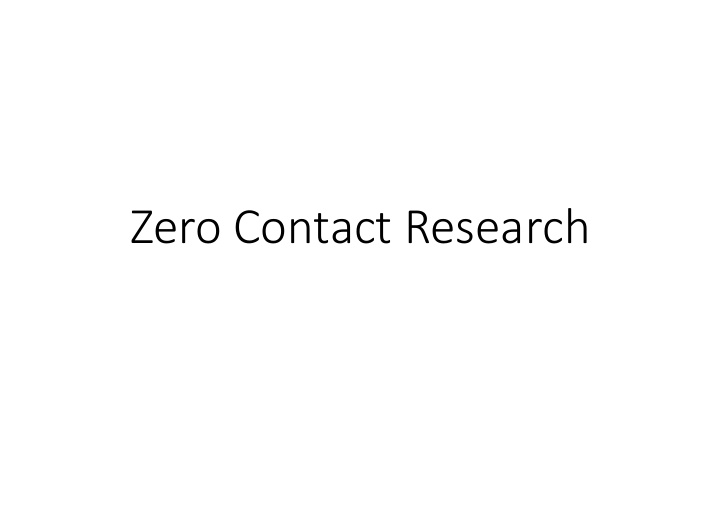



Zero Contact Research
Survey on Expert-Level Gesture Use and Adoption on Multi-touch Tablets • Small component of Jeff’s Ph.D. thesis • Point study • Defines a set of basic gestures and notes existence of enhanced gestures • Are enhanced gestures used?
Method: On-line Survey • Defensive writing We chose an online survey as a data collection method for • Any method of data the same reasons proposed collection has by Kjeldskov et al. [5]: advantages and external validity. Our goal is to collect responses related disadvantages to software features used "in- • Surveys? the-wild" during day-to-day interactions, which is difficult to accomplish in a controlled lab environment. A similar approach was taken by Snowdon et al. [13] when assessing a mobile map navigation technique.
Method: On-line Survey • Defensive writing • Any method of data collection has advantages and disadvantages • Surveys? • Design • Tree structure (yes/no options with follow-up including teaching gesture.
Results: Descriptive Statistics • Different categorical variables Our users are relatively (i.e. counts) experienced: 60.8% have owned an iPad for at least 2-3 years (62/102), • Results are descriptive statistics while 15.7% have owned it for a plus correlations across "longer period" (16/102). Daily demographic factors usage was high: 72.6% use it for at • Numerical -> numerical least 30 minutes (77/106), and correlation = correlation 41.5% use it for more than 60 coefficient (r) minutes each day (44/106). As • Categorical -> categorical, i.e. expected, most users use their tabular data = chi-square statistic iPads for media consumption and social media (Figure 3). Although there was no correlation between age and experience-level (X2 =17.1, NS), there were differences in usage patterns: for instance, younger participants watched more videos (X2 =15.9, p < 0.01).
Amazon Mechanical Turk Studies • Implement studies (e.g. in Javascript, html/CSS, etc.) • Deploy on mechanical turk • Pay workers and get your data • Benefits • Large, heterogeneous group of users. • If you pay well, lots of data fast. • Risks • Data quality
Turkers and Quality Control Silberman et al. [30] recently [A] number of quality control noted that demographics mechanisms have become have shifted in the past five popular, such as redundancy, years and that “professional reputation systems, ground Turkers” now complete most truth seeding, statistical tasks in the system and have filtering, and expert review. a stronger incentive than Providing feedback through other workers to seek out “shepherding” can also lead high paying tasks and to higher quality work. At a perform them well high level, these approaches can be grouped into up-front task design approaches versus posthoc result analysis approaches.
Crowdsourced vs. Lab-based Performance Data • Some work existed on desktop (mouse) performance data • Wanted to compare with touch-based performance data • Tasks described to right
Experiment • N = 30 in lab • N = 202 mechanical turkers • Half each for mouse/touch • Results show lower accuracy for touch, not much difference for mouse
Age-Matched Participants Experiment • N = 30 in lab • N = 202 mechanical turkers • Half each for mouse/touch • Results show lower accuracy for touch, not much difference for mouse
Experiment 2: Some positives • Crowd will take instruction • Told crowdworkers to place tablet flat, see data that looks like lab for movement, perhaps a bit more rotation
With pandemic and limited contact • Mechanical Turk • Can be a good source of UI/experimental data if your experiment can be coded to run on personal devices • Gain: Can do work with specialized systems if it is (at least somewhat) commercially available • Risks: limited participant pool, specialized participants so unsure of generalizability • On-line surveys • Essentially a type of closed interview where participants answer specific questions. • Gain: Easy to deploy, flexible, fast, cheap (free in many cases) • Risks: Need very careful design, require highly targeted (and preferably closed) questions • On-line interviews • Video-based interviewing to mimic in-person data collection • Gain: fast data collection, cheap, more flexibility than questionnaires re format (semi-structured, etc.), easy recording of audio and video. • Risks: Somewhat artificial, harder to establish rapport.
With pandemic and limited contact • Targeted sampling • See Caesar’s paper, provided as reference • Gain: heterogeneous users, fast data collection, relatively inexpensive • Risks: need good instruction, aspects of control vanish due to heterogeneous environments, must run on widely available hardware (not good for VR, tracking, etc.) • Hardware exchange • Package specialized hardware and deploy it to participants using limited contact • Gain: Full flexibility to use specialized systems • Risks: Uncontrolled environment, hardware risk, etc. • Diary studies • Have participants record data of interest • Gain: Almost un-impacted by pandemic, can do post-collection interviewing via skype, generalized mobile apps to collect data. • Risks: Data that you collect will be impacted by pandemic, may not generalize beyond now.
Recommend
More recommend